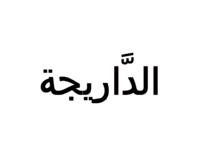Moroccan dialect
| Moroccan Darija | |
|---|---|
| الدارجة Darija | |
 |
|
| Pronunciation | [ddæɾiʒæ] |
| Native to | Morocco |
|
Native speakers
|
21 million (1995) |
|
Afro-Asiatic
|
|
| Latin alphabet, Arabic alphabet | |
| Language codes | |
| ISO 639-3 | |
| Glottolog | moro1292 |
Moroccan Darija (الدارجة, [ddæɾiʒæ] in Morocco) or Moroccan Arabic is a member of the Maghrebi Arabic language continuum spoken in Morocco. It is mutually intelligible to some extent with Algerian Arabic and to a lesser extent with Tunisian Arabic. It has been heavily influenced by Berber, French, and Spanish.
While Standard Arabic language is not spoken in daily life and is used for official communications by the government and other public bodies, Darija has a strong presence in Moroccan television entertainment, cinema and commercial advertising and is the most commonly spoken language in daily life.
It is spoken by approximately half of Morocco's population. The other half speaks one of the three Berber languages (either Tarifit, Tachelhit or Tasoussit).
Moroccan Darija is a cover term for several distinct dialects of Arabic several belonging to two genetically different groups: pre-Hilalian and Hilalian dialects.
Pre-Hilalian dialects are a result of early Arabization phases of the Maghreb, from the 7th to the 12th centuries, concerning the main urban settlements, the harbors, the religious centres (zaouias) as well as the main trade routes. The dialects are generally classified in three types: (old) urban, "village" and "mountain" sedentary and Jewish dialects. In Morocco, several pre-Hilalian dialects are spoken:
Hilalian, or Bedouin, dialects were introduced to Morocco following the settlement of several Hilalian and Mâqilian tribes in western Morocco brought by the Berber Almohad king Yaqub Mansur.
...
Wikipedia
